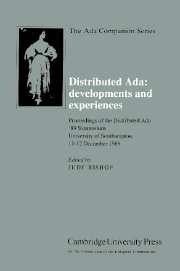 Distributed Ada: Developments and Experiences
Distributed Ada: Developments and Experiences Book contents
- Frontmatter
- Contents
- Preface
- Distributed Ada – the Issues
- Distributed Ada – a Case Study
- Parallel Ada for Symmetrical Multiprocessors
- The York Distributed Ada Project
- From DIADEM to DRAGOON
- Honeywell Distributed Ada – Approach
- Honeywell Distributed Ada – Implementation
- Ada for Tightly Coupled Systems
- A Pragmatic Approach to Distributed Ada for Transputers
- Distributed Ada on Shared Memory Multiprocessors
- The MUMS Multiprocessor Ada Project
- A Portable Common Executable Environment for Ada
- Supporting Reliable Distributed Systems in Ada 9X
Distributed Ada on Shared Memory Multiprocessors
Published online by Cambridge University Press: 13 October 2009
- Frontmatter
- Contents
- Preface
- Distributed Ada – the Issues
- Distributed Ada – a Case Study
- Parallel Ada for Symmetrical Multiprocessors
- The York Distributed Ada Project
- From DIADEM to DRAGOON
- Honeywell Distributed Ada – Approach
- Honeywell Distributed Ada – Implementation
- Ada for Tightly Coupled Systems
- A Pragmatic Approach to Distributed Ada for Transputers
- Distributed Ada on Shared Memory Multiprocessors
- The MUMS Multiprocessor Ada Project
- A Portable Common Executable Environment for Ada
- Supporting Reliable Distributed Systems in Ada 9X
Summary
ABSTRACT
The Ada multi-tasking model is one in which tasks can run on separate processors and memory is either non-shared (local to one task), or shared (referenced by more than one task). It would therefore seem that mapping Ada onto a multi-processor architecture with both local and shared memory should be straightforward. This paper examines the difficulties in mapping Ada onto the IBM RP3 which is an example of such an architecture. In practice there are a number of difficult problems, the most significant of which is the inability to determine at compile time which variables are shared. The RP3 has a flexible shared memory architecture, and an important purpose of the Ada/RP3 project is to investigate possible models for implementation of Ada, with a view to determining whether modifications or enhancements of Ada are desirable to ensure optimal use of such architectures.
INTRODUCTION
The NYU Ada/Ed system consists of a front end and interpreter written entirely in C. This system is a direct descendant of the original SETL interpreter, and has been ported to a wide variety of machines [KS84].
Our current research involves porting Ada/Ed to the IBM RP3, an experimental multi-processor with shared memory [P87]. The front end is essentially unchanged, except for the addition of a set of pragmas described later, but the backend is being modified to interface with proprietary IBM code generating technology, and the runtime library is being rewritten to take advantage of the multi-processor architecture.
- Type
- Chapter
- Information
- Distributed Ada: Developments and ExperiencesProceedings of the Distributed Ada '89 Symposium, University of Southampton, 11–12 December 1989, pp. 222 - 234Publisher: Cambridge University PressPrint publication year: 1990
- 2
- Cited by
